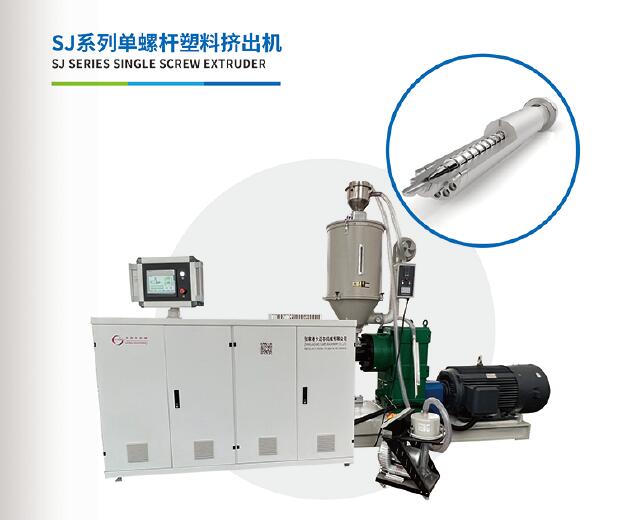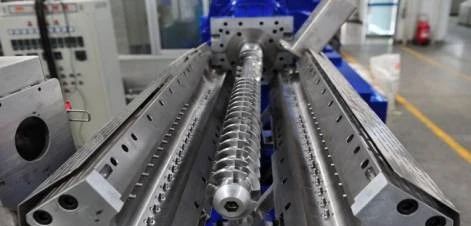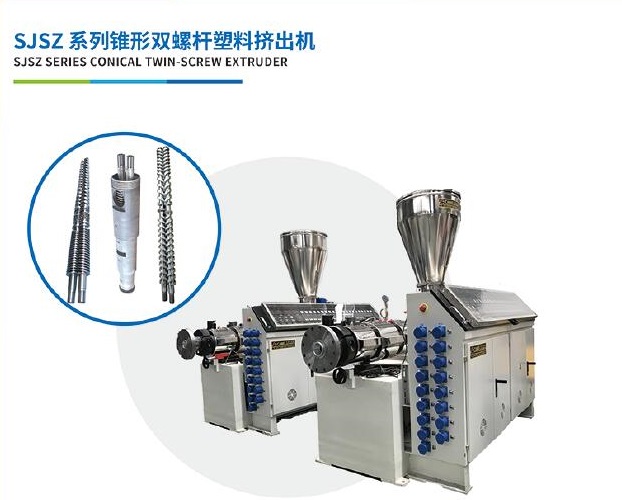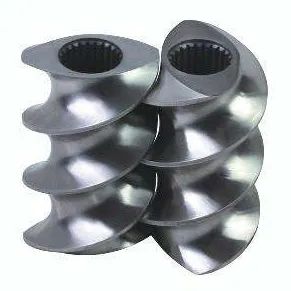Copyright © 2021 Zhangjiagang Camel Machinery Co., Ltd. All rights reserved. Site Map Powered by iwonder.cn
- Phone/WeChat/WhatsApp: 0086-15895699263
- Email: sales@camelmachine.com
How to distinguish single screw extruder and twin screw extruder ?
At present, extruders in the domestic plastics industry are roughly divided into two categories, one is a single-screw extruder and the other is a twin-screw extruder. Because these two types of equipment have their own characteristics, they are widely used in the plastics industry. . So what are the advantages of these two extruders, and what are the differences between them?
1. Introduction and uses of single and twin screw extruders
1. Single screw extruder

As the name suggests, a single-screw extruder has a screw inside the barrel.

01.Introduction to single screw extruder
Single-screw extruders are generally divided into three sections in terms of effective length. The effective length of the three sections is determined according to the screw diameter, screw pitch, and screw depth. Generally, each section is divided into one-third.
The first section: Starting from the last section of thread of the material opening, it is called the conveying section. The material here is required not to be plasticized, but must be preheated and pressed hard. In the past, the old extrusion theory believed that the material here was a loose body. Later, it was proved that the material here is actually a solid plug, which means that the material here is extruded. The last part is a solid like a plug, so as long as it completes the transportation task, that is its function.
The second section is called the compression section. The volume of the screw channel in this section gradually decreases from large to small, and the temperature needs to reach the plasticization level of the material. Compression occurs here (from the third conveyor section, it can be compressed to one here. This is called the compression ratio of the screw - 3:1. There is The machines are also different), and the plasticized material enters the third stage.
The third section: measurement section. The material here maintains the plasticizing temperature, but the melt material is transported accurately and quantitatively like a metering pump to supply the machine head. At this time, the temperature cannot be lower than the plasticizing temperature, usually slightly higher.
The high-efficiency single-screw extruder adopts a two-stage overall design to strengthen the plasticizing function and ensure high-speed, high-performance and stable extrusion. The comprehensive mixing design ensures the mixing effect of the material, and the high-shear and low-melt plasticizing temperature ensures High-performance low-temperature and low-pressure metering extrusion of materials.
02.Single screw extruder maintenance:
1. Since the electrical control system has high requirements for ambient temperature and dust prevention, the electrical system should be isolated from the production site and ventilation or ventilation fans should be installed. It is recommended to place the electrical control cabinet in a simple room to keep the room clean and Ventilate to keep the indoor temperature no higher than 40℃.
2. The single-screw extruder is not allowed to run empty to prevent the screw and the machine from being rolled. When the host starts idling, it is not allowed to exceed 100r/min; when starting the host, start at a low speed. After starting the host, check whether there is any abnormal noise, and then slowly increase the speed of the host to within the allowable range of the process (it is better to adjust it to the best state). When the new machine is running in, the current load should be 60-70%, and the current during normal use should not exceed 90%. Note: If abnormal noise occurs when the extruder is running, it should be stopped immediately for inspection or repair.
3. Turn on the oil pump first when starting up, and turn off the oil pump after turning off the machine; the water pump remains in working condition during the entire production process, and the operation of the water pump cannot be stopped to prevent the temperature of the barrel from rising, causing the material in the barrel to decompose and carbonize; the asbestos fan cover of the main motor fan needs to be Clean it frequently to prevent excessive dust from clogging the windshield and causing the motor to trip due to insufficient heat dissipation due to overheating.
4. Clean the dirt, tools and debris on the surface of the unit promptly.
5. Be careful to prevent metal or other debris from falling into the hopper to avoid damaging the screw and barrel. In order to prevent iron debris from entering the barrel, a magnetic component or magnetic frame can be installed at the feeding port of the barrel where the material enters. To prevent debris from falling in, the material must be screened in advance.
6. Pay attention to the cleanliness of the production environment, and do not let garbage and impurities mix into the materials to block the filter plate, which will affect the product output and quality and increase the resistance of the machine head.
7. The reduction gearbox should use the lubricating oil specified in the machine manual, and add the oil according to the specified oil level. Too little oil will result in insufficient lubrication, which will reduce the service life of the parts; too much oil will cause high heat generation, high energy consumption, and loss of oil. It is easy to deteriorate, which will also cause lubrication failure and cause damage to parts. The sealing gasket (ring) should be replaced in time for oil leakage parts of the reduction gearbox to ensure the amount of lubricating oil.
03.Main uses:
Mainly used in the extrusion of pipes, sheets, plates, and special profiles, and the granulation of some modified materials.
2. Introduction and uses of twin-screw extruder

01 Twin screw extruder
The twin-screw extruder is divided into the following system parts:
1. Feeding system: including hopper, mixing motor, and feeding motor. It can prevent the accumulation of materials and facilitate their smooth entry into the feed port.
2. External heating system: It mainly uses heating rods and cylinders to efficiently heat materials and promote plasticization.
3. Cooling system: Use a heat exchange system composed of thermal oil or water to reduce the heat of the fuselage, thereby effectively controlling the temperature of the cylinder.
4. Hydraulic screen changing system: Use replaceable filters to intercept impurities, improve the degree of plasticization, and ensure the uniformity and stability of the quality of the output materials.
5. Vacuum system: extract moisture and other low-molecular volatiles from the material.
6. Electronic control system: Responsible for monitoring and controlling related equipment of the main and auxiliary material systems.
7. Screw system: The most important component of the extruder, which can be divided into conveying section, melting section (exhaust port), plasticizing section (vacuum port), and discharge section.
The screw system mainly completes the plasticization and transportation process of materials, which has a great impact on the performance and quality of the finished products. The screw parameter settings of different models and equipment from different manufacturers are different, so you need to pay special attention to them.
02 Segments of screw
The screw system of a parallel twin-screw extruder is generally divided into 4 sections: conveying section, melting section (exhaust port), plasticizing section (vacuum port), and discharge section.
1. Conveying section: The function is to transport materials and prevent material return.
2. Melting section: This section uses heat conduction and frictional shear to fully melt and mix the materials.
3. Plasticizing section: It further melts and mixes the ingredients of the material, and has the functions of distributive and dispersive mixing.
4. Discharging section: Conveying and pressurizing, forming a certain pressure to make the materials more compact and further mixing to achieve the purpose of extrusion and granulation.
03 Conveying elements
1. Types are divided into:
(1) Large lead
(2) Small lead
2. Effect of lead use: The more leads, the increase in screw extrusion volume, the shorter the material residence time, and the weaker the material mixing ability.
3. The common use method of small lead: gradually reduce the combination, and is used in the conveying section, melting section, and plasticizing section to pressurize and improve melting; improve the homogenization degree of the mixture and the stability of the transportation volume.
4. For adjustment, please refer to Part 3 "Key Points of Screw Adjustment".

Elements
04 shear element
1. Direction classification: forward and reverse. Forward, it promotes the flow of materials and realizes its functions; reverse, also called counter-rotation, has a backflow effect on the transportation of materials, prolongs the residence time of materials, enhances plasticizing capacity, and improves the mixing effect.
2. Angle classification: generally divided into 30°, 45°, 60° and 90°.
3. Function and effect: In the forward direction, the staggering angle is increased, the conveying capacity is reduced, the residence time is extended, and the degree of plasticization is increased. For dispersion, the larger the angle, the more obvious the effect; dispersion mixing is generally best when the angle is 45°, followed by 30°, and the worst is 60°.
4. Effect of number of heads:
(1) In the forward direction, the fewer the heads, the greater the extrusion conveying capacity, the greater the torque, and the better the mixing effect, but the less shearing effect;
(2) In reverse direction, the fewer the heads, the smaller the extrusion conveying capacity and the better the mixing effect.
5. Key points of screw adjustment
The interrelationships between the screw parameters and their related influencing components are listed, and a reference for adjusting the screw is provided.
3. The difference between single and twin screw extruders
After briefly introducing twin-screw extruders above, let’s take a closer look at the differences between these two extruders in terms of price, operability, screws, etc.
1. Single screw is cheaper
The single-screw extruder has a simple structure and low price;
The twin-screw structure is complex and the price is high. Twin-screw extruders are about twice as expensive as single-screw extruders. Individually, it will be higher, depending on the manufacturer and model.
2.Single screw formula is simple
To be honest, in terms of operation, there is actually not a big difference between the two. However, the process and formula of a single-screw extruder are relatively simple, while the process, process and formula of a twin-screw extruder are more complex.
3. Twin screws can be freely combined.
Twin-screw threads can be combined at will according to the material conditions and the operator's mood. Anyway, as long as you are happy;
A single screw is relatively rigid and cannot be combined.
4. Twin screws are more efficient
Twin-screw extruders have large output, fast extrusion speed, and low energy consumption per unit output, while single-screw extruders are inferior. The efficiency of twin-screw extruders is about twice that of single-screw extruders. It depends on the manufacturer and model.
5. Twin-screw mixing and plasticizing ability is strong
To put it simply, the single screw is suitable for plasticizing extrusion of polymers and extrusion processing of pellets, such as molding, film blowing, injection molding, etc., and uses a wide range of materials;
The twin-screw extruder has good mixing and plasticizing capabilities and is more suitable for the modification of plastics. And the twin-screw extruder can produce two colors.
6. Single screw for easy maintenance
In terms of maintenance, single screws are simpler than twin screws because the structure of a single screw is relatively simple and easy to repair.
7.Conveying mechanism
The transportation of a single-screw extruder mainly relies on the friction generated between the material and the barrel. The counter-rotating twin-screw extruder is forward conveying, which has the effect of forcing the material forward, and the counter-rotating twin-screw extruder The mesh of the two screws also produces shearing effect on the material. (For counter-rotating twin-screw extruders)
8.Velocity field
While the velocity distribution in a single-screw extruder is relatively clear and easy to describe, the situation in a counter-rotating twin-screw extruder is quite complex and difficult to describe. This is mainly because the screw has a meshing area. The complex flow that occurs in the meshing area gives it many advantages such as sufficient mixing, uniform heat transfer, strong melting ability, and good exhaust performance. However, it is difficult to accurately analyze the flow state of the meshing area. (For counter-rotating twin-screw extruders)
9. Application examples
Application examples of twin-screw extruders: glass fiber reinforced, fuel retardant granulation (such as PA6, PA66, PET, PBT, PP, PC reinforced flame retardant, etc.), high filler granulation (such as PE, PP filled 75% CaCO3), granulation of heat-sensitive materials (such as PVC, Such as sheathing materials, insulation materials), XLPE pipe material granulation (such as masterbatch for hot water cross-linking), thermosetting plastic mixing and extrusion (such as phenolic resin, epoxy resin, powder coating), hot melt adhesive, PU reaction extrusion granulation (such as EVA hot melt adhesive, polyurethane), K resin, SBS devolatilization granulation, etc.
Single-screw extruder application examples: suitable for PP-R pipes, PE gas pipes, PEX cross-linked pipes, aluminum-plastic composite pipes, ABS pipes, PVC pipes, HDPE silicon core pipes and various co-extruded composite pipes; suitable for PVC , PET, PS, PP, PC and other profiles and sheets, and other plastics such as wire, rods, etc.; adjusting the extruder speed and changing the structure of the extrusion screw can be applied to the production of PVC and polyolefins and other various plastic profiles.